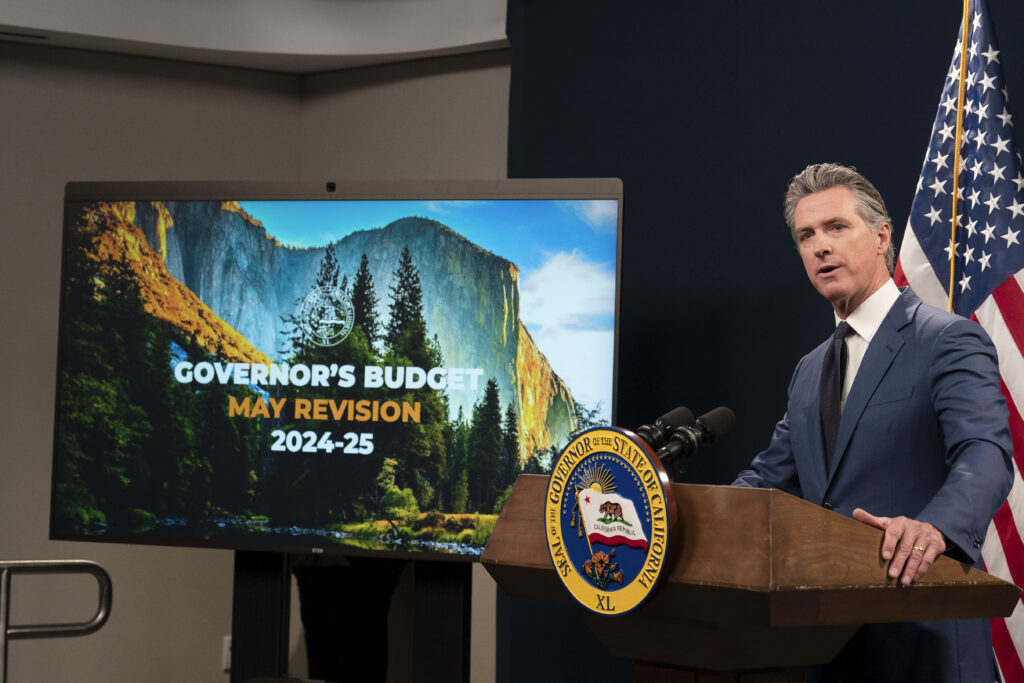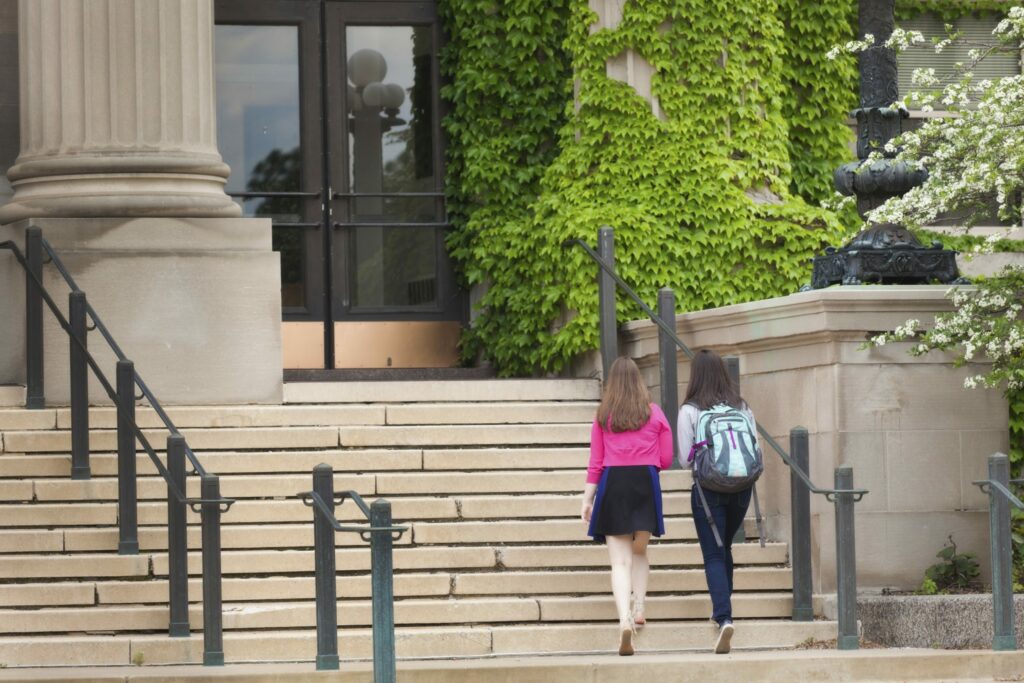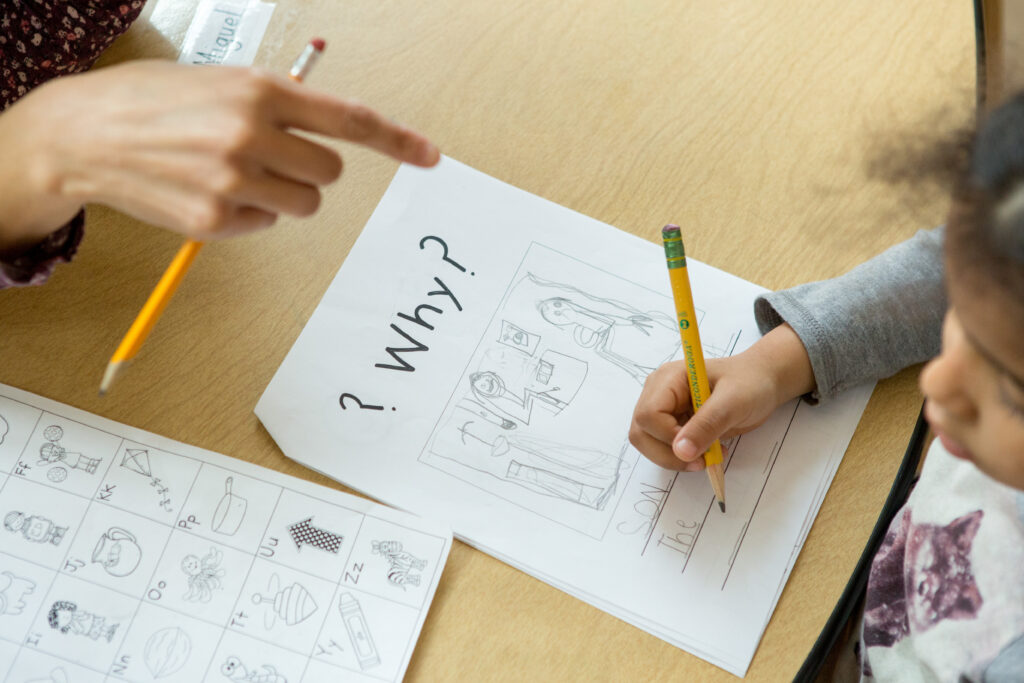
Gov. Gavin Newsom unveils his revised 2024-25 state budget during a news conference in Sacramento on May 10, 2024.
Credit: AP Photo / Rich Pedroncelli
Despite a further deterioration in state revenues, Gov. Gavin Newsom again pledged Friday to protect ongoing funding and the large-scale initiatives for TK-12 schools that he has set in motion.
“I just don’t want to see education cuts,” Newsom said during a news conference on the revision to the proposed 2024-25 state budget he presented in January. “Right now, I want to see us preserve the progress we have made on community schools, on preschool, on after-school-for-all, summer school — all the work we’ve been doing.”
Newsom’s comment during a two-hour session with reporters reflected the challenge of writing annual budgets subject to volatile revenue fluctuations dependent on the incomes of the top 1% of earners. Receipts from capital gains taxes that soared to $349 billion in 2021-22 dropped to $137 billion in 2023-24. The current fiscal year ends June 30.
As a result of the projected shortfall, other state operations could face additional cuts. Newsom didn’t make the same promise he made for schools to higher education, leaving California State University system officials on edge. In a statement, CSU Chancellor Mildred Garcia said she was “deeply concerned” about a revised state budget that would grant no increase next year, then a 2% increase in 2025-26, instead of a 10% increase over two years as promised in January.
“As the institution that educates the evolving workforce of California, this budget places us in a position of making difficult decisions,” Garcia said.
It was not clear whether the University of California would face similar cuts, although Newsom typically treats both systems similarly. UC officials would not comment on the issue. In a statement Friday, UC President Michael Drake said that the system is hoping to “finalize a budget that sustains the University’s research, public service, and education mission.”
The summary of revenue reductions and spending cuts Newsom released lacked the details that usually accompany a May budget revision; however, more information is expected by Tuesday, the deadline for statutory budget language.
Some TK-12 advocates expressed relief, nonetheless.
“Given the magnitude of the fiscal crisis, that the governor could put together a budget that largely protects K-12 is remarkable,” said education consultant Kevin Gordon, president of Capitol Advisors.
Derick Lennox, senior director of governmental relations and legal affairs with the California County Superintendents, was more cautious. “We can appreciate the governor’s commitment to hold schools harmless to the extent he can, but so much will all depend on the details for Proposition 98 and what is available,” he said, referring to the portion of the general fund that determines funding for TK-12 schools and community colleges.
Newsom said general fund revenues were expected to decline an additional $7 billion for a total of $27.6 billion for the three-year period from 2022-23 through 2024-25. The total deficit would be nearly twice as big, but the Legislature has made a combination of cuts, savings, and deferred spending since January.
The shortfall for TK-12 and community colleges, due to lower Proposition 98 funding, would be about $4.2 billion. Although details are scant, Newsom would make up for it mostly by emptying nearly all the remaining $9 billion rainy day fund for schools and community colleges.
Newsom said the average TK-12 per-student funding for 2024-25 would be $17,502 — $151 per student less than proposed in January. Despite that, funding would include a 1% cost of living increase, a smidge higher than in January.
The May revision lists about $1 billion in cuts for early education through high school. Most of the programs are funded by the general fund, not Proposition 98. It would preserve ongoing funding for the expanded transitional kindergarten program for 4-year-olds and long-awaited pay raises for child care providers.
Cuts would include:
- $425 million to the Children and Youth Behavioral Health Initiative out of a $4 billion investment, which Newsom said would reflect directing more funding to wellness centers at school sites. Carl Pinkston of the Black Parallel School Board expressed concern. “In the aftermath of the pandemic, many students continue to display signs of trauma, adversely affecting their academic performance and overall well-being,” he said. The initiative “is a critical program that champions equity, aiming to improve behavioral health outcomes for children and youth.”
- Delayed funding for additional slots for state-funded child care. Instead of funding 146,000 as planned, the state will continue funding 119,000 new slots funded so far. “Delaying access to child care for the next two years to our youngest Californians is deeply troubling,” said Mary Ignatius, executive director of Parent Voices CA, an advocacy group. “Their childhoods do not pause. Their undiagnosed speech or other developmental delays will make it harder for them two years from now.”
- Elimination of $550 million in facilities funding for preschools, transitional kindergarten and full-day kindergarten programs. Newsom suggested funding could be included in a statewide school facilities bond. He said Friday that negotiations were continuing with legislative leaders for a bond on the statewide ballot in November.
- A cut of $60.2 million to the Golden State Teacher Grant Program, which pays up to $20,000 to teacher candidates enrolled in credential programs who commit to working for years in priority schools.
- Elimination of $48 million in 2025-26 and $98 million in 2026-27 for increased payments for state preschools that serve additional students with disabilities.
- A cut of all but $100 million in ongoing funding for the Middle Class Scholarship Program, which previously received more than $600 million annually. In past years, more than 300,000 students across UC and CSU have received scholarships, which are available to students whose families earn up to $217,000.
Criticism of a key fix to the shortfall
Newsom’s solution for minimizing cuts to schools and community colleges would rely on a controversial maneuver. He would fill in the biggest piece of the shortfall — $8 billion in an unanticipated drop in Proposition 98 revenue in 2022-23 — by treating it as an overpayment of the state’s funding obligation. Since schools and community colleges have already spent the money, he’d fill in the gap by cutting the general fund — but not until 2028-29, when the state’s revenue picture presumably would have improved. Since Newsom announced the idea in January, the repayment obligation has grown to $8.8 billion.
An accounting move of that magnitude hasn‘t been done before. The Legislative Analyst Office (LAO) has questioned the tactic, and so did the California School Boards Association in a statement Friday in which it implied it might sue.
The association’s logic reflects the complexity of the Proposition 98 formula for determining funding. The school boards association asserts that the 2022-23 funding level was not a voluntary overpayment but rather a constitutional obligation on which subsequent years’ levels of funding are set.
“This accounting gimmick would lower the baseline for calculating education funding in subsequent years, subjecting California schools to lower revenue for the foreseeable future,” school boards association President Albert Gonzalez said. “This sets a terrible precedent that potentially destabilizes education funding and undermines the voters’ intent when they passed Proposition 98 more than 35 years ago.”
The California Department of Finance has insisted that the solution is legal. However, on Friday, Newsom did acknowledge that Proposition 98 is complicated.
“You need not only a Ph.D., but a physics degree, an engineering degree and everything else to unpack its complexities,” he said.














